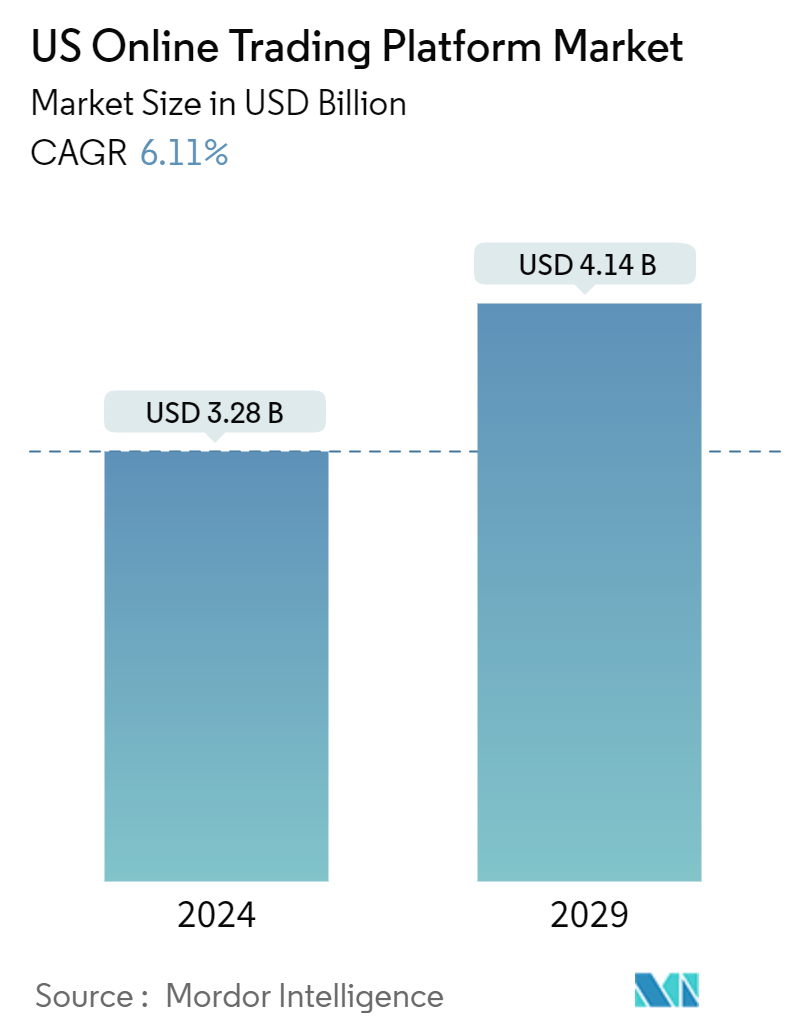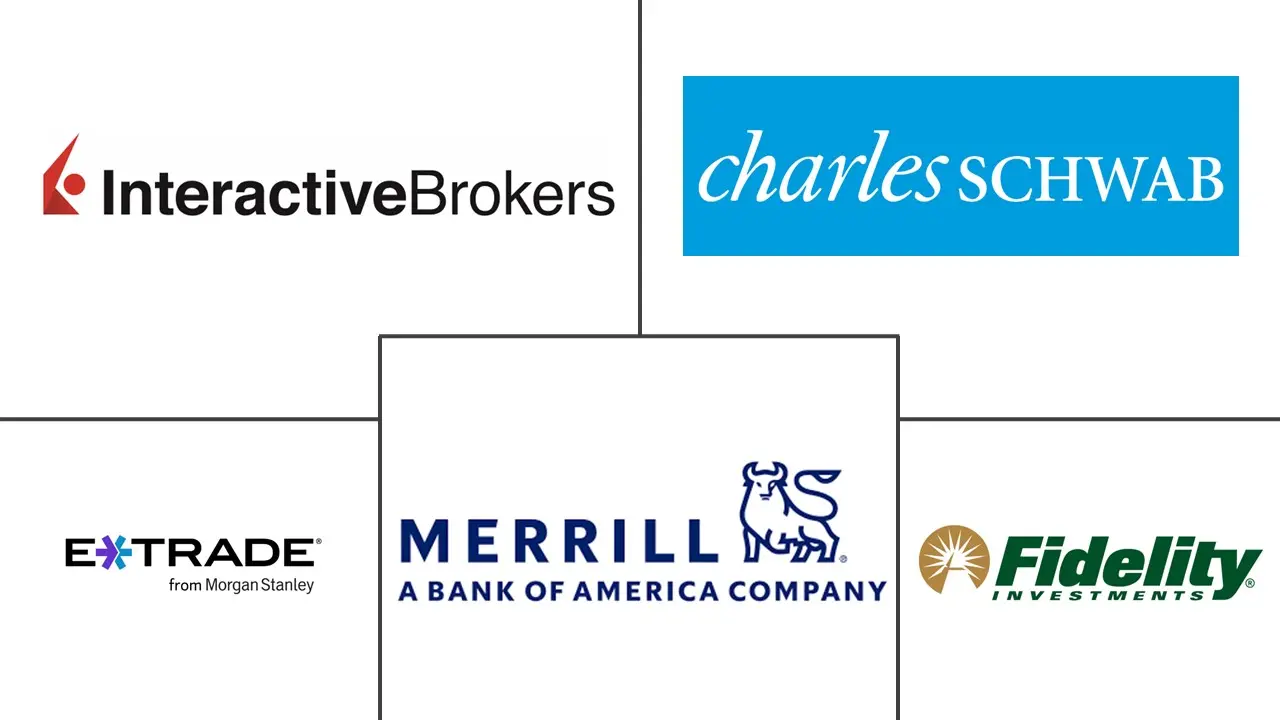Market Size of US Online Trading Platform Industry

| Study Period | 2019 - 2029 |
| Base Year For Estimation | 2023 |
| Market Size (2024) | USD 3.28 Billion |
| Market Size (2029) | USD 4.14 Billion |
| CAGR (2024 - 2029) | 6.11 % |
| Market Concentration | Low |
Major Players
*Disclaimer: Major Players sorted in no particular order |
US Online Trading Platform Market Analysis
The US Online Trading Platform Market size is estimated at USD 3.28 billion in 2024, and is expected to reach USD 4.14 billion by 2029, growing at a CAGR of 6.11% during the forecast period (2024-2029).
The growing accessibility with the increasing penetration of smartphones, Integration of AI technology, and robo advisors to notify on real-time updates and Capabilities, such as trade order and investment management integrated into a single platform, majorly drive the market growth rate during the forecast period.
The growing innovations in integrating AI in the banking sector are analyzed to create demand during the forecast period, owing to the rising collaborations in the sector. For instance, in May 2023, BNY Mellon declared its aim to implement an AI-based apparatus to develop further its substance goal administration in its client data set. The bank planned for this implementation to be a part of its ongoing efforts to improve data management and meet regulatory requirements for identifying customers and their banking relationships.
The increasing accessibility and rise in the adoption of smartphones have played a significant role in driving the market of online trading platforms in the United States. The widespread adoption of smartphones has provided individuals with easy access to the Internet and various online services, including online trading platforms. With smartphone trading apps, investors and traders can monitor and manage their portfolios and execute trades with access to real-time market information anytime and anywhere. In this way, smartphones have democratized trading, enabling individuals to participate in the financial markets easily.
The integration of AI technology and robo-advisors has revolutionized how investors access and utilize real-time data updates. As AI technology combined with online trading platforms reduces research time and improves accuracy by automating research and data-driven decision-making, with the requirement of less time spent on researching and more time overseeing actual trades, the adoption of such platforms is increasing rapidly by retail traders and investors. Thus, online trading platform providers in the United States are adopting technology-based advancements in their online trading platforms.
The increasing risk of counterfeiting activities in online trading platforms undermines investors' and traders' confidence and trust in the platform providers. The counterfeiting activity experienced by the user related to financial products offered on the platform may result in a lack of trust and adoption, reducing trading activities and thereby hindering the growth of the online trading platform market.
US Online Trading Platform Industry Segmentation
The US online trading platform market is defined based on the revenues generated from solutions used by various end users across the United States. The analysis is based on the market insights captured through secondary research and the primaries. The market covers major factors impacting the market's growth in terms of drivers and restraints. The scope of the study has been segmented based on the offerings (platforms and services), by deployment (cloud and on-premises), by type (beginner and advanced), and by end-user (institutional and retail investors) across the United States. The market sizes and forecasts are provided in terms of value in USD for all the above segments.
The study tracks key market parameters, underlying growth influencers, and major vendors operating in the industry, which supports the market estimations and growth rates over the forecast period. The study also tracks the revenue accrued from the solutions used in various end-user industries across the United States. In addition, the study provides the US Online Trading Platform market trends and key vendor profiles. The study further analyzes the overall impact of COVID-19 on the ecosystem.
| By Offerings | |
| Platforms | |
| Services |
| By Deployment Mode | |
| On-Premises | |
| Cloud |
| By Type | |
| Beginner | |
| Advanced |
| By End-user | |
| Institutional Investors | |
| Retail Investors |
US Online Trading Platform Market Size Summary
The United States online trading platform market is experiencing significant growth, driven by the increasing accessibility of smartphones and the integration of advanced technologies like AI and robo-advisors. These innovations have transformed how investors engage with financial markets, allowing for real-time data updates and streamlined trading processes. The convenience of mobile trading apps has democratized access to financial markets, enabling retail investors to manage their portfolios and execute trades from anywhere, thereby boosting market participation. However, challenges such as counterfeiting activities pose risks to investor confidence, potentially hindering market expansion.
The market is characterized by a diverse range of platform offerings, including brokerage, forex, options, and cryptocurrency trading platforms, each tailored to meet the needs of various financial instruments and strategies. Rapid technological advancements, such as high-speed internet and sophisticated trading algorithms, have led to the development of more robust and user-friendly platforms. The popularity of mobile trading continues to rise, with cloud-based deployment gaining traction among various platform types. Prominent players like Fidelity, Charles Schwab, and E*TRADE are enhancing their offerings through technological integrations, further distinguishing their services in a highly fragmented market.
US Online Trading Platform Market Size - Table of Contents
-
1. MARKET INSIGHTS
-
1.1 Market Overview
-
1.2 Industry Attractiveness - Porter's Five Forces Analysis
-
1.2.1 Bargaining Power of Suppliers
-
1.2.2 Bargaining Power of Buyers
-
1.2.3 Threat of New Entrants
-
1.2.4 Threat of Substitute Products and Services
-
1.2.5 Intensity of Competitive Rivalry
-
-
-
2. MARKET SEGMENTATION
-
2.1 By Offerings
-
2.1.1 Platforms
-
2.1.2 Services
-
-
2.2 By Deployment Mode
-
2.2.1 On-Premises
-
2.2.2 Cloud
-
-
2.3 By Type
-
2.3.1 Beginner
-
2.3.2 Advanced
-
-
2.4 By End-user
-
2.4.1 Institutional Investors
-
2.4.2 Retail Investors
-
-
US Online Trading Platform Market Size FAQs
How big is the US Online Trading Platform Market?
The US Online Trading Platform Market size is expected to reach USD 3.28 billion in 2024 and grow at a CAGR of 6.11% to reach USD 4.14 billion by 2029.
What is the current US Online Trading Platform Market size?
In 2024, the US Online Trading Platform Market size is expected to reach USD 3.28 billion.

